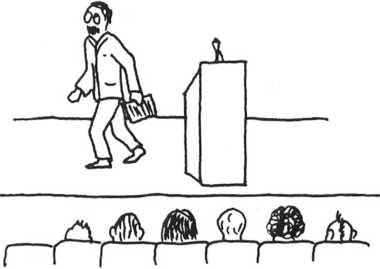CHAPTER ONE — INTRODUCTION

Purpose and Method
 This work
presents a new approach for reconstructing the geography of prehistoric language differentiations
and distributions. It is made explicit in the form of a complete reconstruction of the origin and
distribution of all present European languages, and many extinct ones as well. Both the method
itself and the results of its application to Europe are offered for critical evaluation by scholars
in the appropriate fields.
This work
presents a new approach for reconstructing the geography of prehistoric language differentiations
and distributions. It is made explicit in the form of a complete reconstruction of the origin and
distribution of all present European languages, and many extinct ones as well. Both the method
itself and the results of its application to Europe are offered for critical evaluation by scholars
in the appropriate fields.
History has usually concentrated on such things as battles, rulers, and political boundaries. It
can also be said that ethnic history, as measured by language groupings, is an equally important
aspect that is often ignored or given only perfunctory treatment. Prior to written records, the
usual subject material of history is missing, by definition, and informed speculations are then made
about ethnic distributions over time and space. I think that many of these speculations are at least
ill-founded, and are often incorrect. It has proven notoriously difficult to correlate archeology
with language history.
1
What is needed is a rigorous approach to reconstructing linguistic behavior in a geographical
setting — one that recognizes the biology and economy of the human carriers of these languages. Such
an approach should be founded on principles of human ecology, as well as linguistics, that are
applicable to both the prehistoric and historic eras as well. This would take the form of a set of
explicit rules of movement that are consistent with known human behavior, and which are universally
applied. Such a set of rules would be set in motion at some remote time in the past and then
consistently followed through to end up with the actual modern language distribution (Fig. 1).
Fig. 1. Language map of recent Europe. All family distributions are shown prior to World War
II. Many boundaries are simplified, and some small enclaves are combined and enlarged to make them
more visible. Spotty distributions in eastern Russia are so expanded as to approximate the
conditions of over a century ago. Major subdivisions are indicated with thin lines within some
family areas, while Anatolian and Iranian are not separated.
This map represents the goal to be achieved by this and any other reconstruction. |
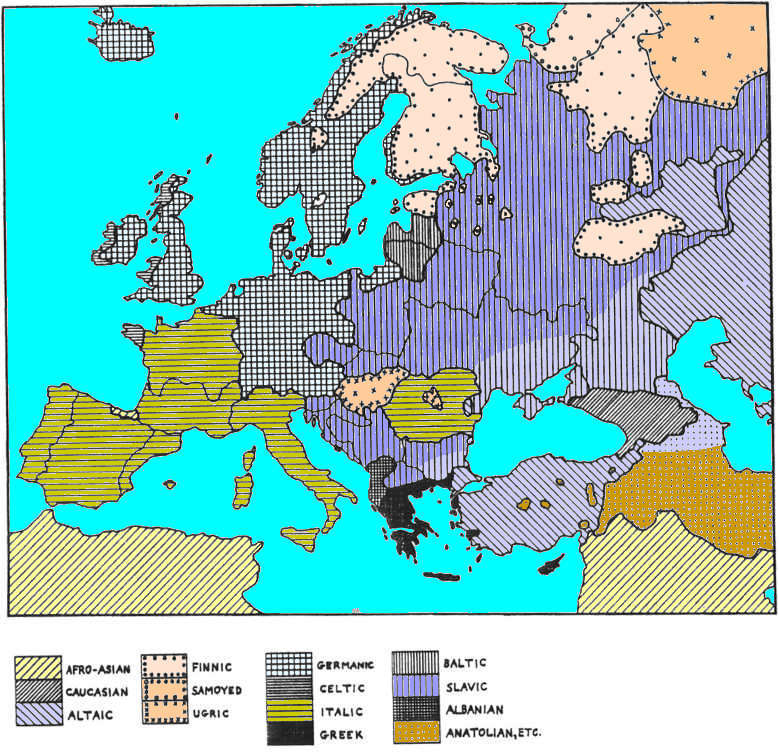 |
This kind of reconstruction must also show reasonable agreement with the known facts of
archeology, history, and linguistics, though it doesn't have to agree with the current speculations
in these fields.
A reconstruction of this type is a model that may be tested against other kinds of
reconstructions, most of which are not criticized here in any detail. Some archeological and
historic data were used to set the times and locations of major events, but otherwise this model was
developed to stand on its own merits and internal consistency. This approach is explicitly not a
compilation of all available knowledge, from all fields, in order to create such a reconstruction.
Instead, it is an essentially independent method whose results should be compared with
reconstructions based on other methods.
The first of two principles of human movement to establish here is that people and their
languages generally do not move.
All peoples will tend to occupy their own territory until some compelling force is brought to
bear to make them change their location (or their ethnic identity). When a group expands into new
territory, this is normally accomplished by a relocation of only the population surplus. There is no
tendency to evacuate most of the residents from their original homeland as long as they can still
live there. It is normally in the best short-term survival interest of all ethnic groups to maintain
their locations and languages as tenaciously as possible. Any suggestion of an instance of contrary
behavior should be accompanied by a sufficient explanation for it. I first argued this point in
print in 1976, it was also stated by Brues (1977:250-51), and it has been elaborated on by others
since then.
2
This means we cannot simply suppose that a group of
barbarians was able to spread out and impose its language over large areas of both civilized and
noncivilized peoples. Further, great migrations of nonliterate peasants cannot be postulated at will
to account for more recent distributions. We cannot just move people all over the map solely to
accommodate proposed linguistic connections. Anthropologically speaking, any migration proposal must
include answers the following questions:
1. Why did the
people
move at all rather than simply remain where they were?
2. Why did they move where they did rather than to some other location?
3. Why did they move when they did rather than at some other time?
4. Why was it they who moved, there and then, rather than some other people?
5. How was the move accomplished over the presumed resistance of the people already occupying
the location?
If any of these questions are unanswered, by statement or implication, the proposal
is correspondingly weak. If none of them are answered, then it is hardly a proposal at all. To
postulate a migration without giving answers to these questions is only to restate a linguistic
distribution in other terms, as though such a restatement somehow explained something.
In 1977 I applied this principle of stability to a reconstruction of the immigration of the first
humans into western North America. In that article my typical answers to the above migration
questions were:
4
1. They did not actually
move, but instead relocated their surplus population as an expansion of their territory.
2. They expanded where the land was available, where it was either unpopulated or vulnerable
to penetration.
3. They expanded when the land was available, or when they acquired the means of penetration.
4. They had better access, or means, than any other people.
5. They prevailed because either the land was empty or they had much greater numbers.
It was thereby shown that at least 95% of the affiliations of the languages and their
distributions in western North America could be exactly accounted for by using this, and one other,
basic principle of human movements. Most particularly, the concept of a series of "waves" of
immigration into the continent had to be ruled out as being inconsistent with the principle of
stability. The few discrepancies between my reconstruction and some standard linguistic opinions
were emphasized in four comments by Baumhoff, Elsasser, Fleisher, and Leonhardy — all 1978.
The second principle used in the North American reconstruction was that a technological
innovation could so increase the numbers, power, and/or prestige of one group that they could
overwhelm their neighbors. This provides specific answers to point 5, how they prevailed if the land
was inhabited.
Individuals, families, and small groups will cross ethnic borders; this is a normal process at
all times. The usual result is that these migrants soon adopt the language of their new neighbors
and linguistically disappear. A great differential in population densities will mean there is a
correspondingly greater flow in one direction. If this one-way excess in flow is great enough and
fast enough for them to maintain regular contact with other immigrants, then they will keep their
language and can instead turn the natives into a minority that is eventually absorbed. As long as
the advantage of one group over the other is maintained, the linguistic frontier will continue to
move in the direction of lower population density.
5
With most innovations the neighboring peoples will
eventually adopt the new item, increase their own influence, and then resist further encroachment by
matching numbers, power, and/or prestige. These people will then press on their neighbors in turn,
still farther from the source of the innovation. In this manner a series of linguistic boundary
shifts, all in the same direction, were systematically described and explained for western North
America.
In reconstructing the linguistic development of Europe one encounters a few innovations that
moved ethnic boundaries in this manner. The most outstanding of these was clearly the initial
appearance of agriculture, which swept over the continent with such force that the local natives
were rarely able to adopt it. This Neolithic revolution would have caused so nearly total an ethnic
replacement that this event is taken here as the effective base-line for all subsequent linguistic
events. That this also represents the introduction of Indo-European languages into the continent is
the most obvious hypothesis to consider first.
|
Pastoralism: In the North America pastoralism did not exist, so it was not a factor in the
assessment. In the Eurasia pastoralism not only existed, but evolved independently of the farming,
as a natural extension of the hunter-gatherer economy, and in the historical, geographical, and
linguistic development played role equivalent to the Anatolian farming. The spread of pastoralism
and its influence followed the same principles as are applied in this work to the spread of farming.
Domestic Pastoralism:
Domestic Pastoralism is an extension of farming, it shares with farming the local anchorage, and
differs from the farming only in the extent of the territory, and correspondingly the population
density. The mobility of the domestic pastoralists does not differ much from that of the farmers, it
is an order of magnitude lower than the mobility of the nomadic pastoralists. The crucial difference
between the domestic pastoralism and nomadic pastoralism is in keeping stabled herds fed by stored
feedstock during unfavorable periods, versus the year-around free range sustenance of the nomadic
herds.
Nomadic Pastoralism:
Nomadic pastoralism is an outgrowth of the battue hunting, when the herds of wild animals are
driven to suitable location for free range sustenance. Nomadic pastoralism is based on permanent
pasturing routs that provide stable year-around supply of naturally-grown feedstock. Nomadic
pastoralism can be sustained in two forms, a local transhumance in deltas and mountains, and
long-distance steppe transhumance. The local transhumance is a special case of the long-distance
steppe transhumance under uniquely specific favorable conditions, under duress it reverts back to
the steppe transhumance.
Foot hunters and mounted hunters: Stipulations on the foot hunters are not applicable to
the mounted hunters. The transition from the foot hunting to the mounted hunting probably initially
occurred in very few focus locations, paralleling that of the farming, and could be tentatively
dated to the first regular mass appearance of the horse and camel bones in the refuse of the hunter
settlements, timed to the 7th mill. BC (9000 ybp). Sustained mass capture of highly mobile animals
is impossible without a comparable mobility of the hunters to switch from hunting individual animals
to animal farming. From that time, following the logic of this work, the practice of animal
husbandry had to spread at a certain speed into the adjacent foot hunter populations, displacing and
absorbing them to a point where the foot hunter-gatherer refuge made the further expansion
impractical, which was the Eurasian taiga belt. The near simultaneous emergence of the farming and
free range animal husbandry made it impossible not to collide at the fringes of their expansions.
The corollary of that is, that the expansion of the nomadic language was much faster than that
of the farming languages, that the density of that expansion was much smaller than that of the
farming languages, and that the innovations were able to traverse huge territories orders of
magnitude faster than that carried by the farmers. Given that in encounters an advantage was always
on the side of the mounted forces, the absence of the mounted animal husbandry expansion bores
heavily on the logic and conclusions of this work. |
My North American reconstruction also included a major episode of depopulation and subsequent
repopulation of large areas that resulted in major shifts of some language boundaries.
A comparable climatic event is identified in this European reconstruction, but its effect on
farmers turns out to be quite different from its effect on hunters.
When a climatic change makes an area uninhabitable to hunters they simply decline in numbers in
that place, with no more than stragglers moving elsewhere. When it becomes obvious that the change
is not just a minor episode, they might want to shift their tribal territory somewhere else. But all
adjacent livable spaces are already occupied by other tribes who may also be suffering, yet who are
not so weak as those desiring to move in. Without large quantities of transportable food supplies,
the afflicted population has no recourse but to gradually fade out of existence.
6
With an agricultural population under similar pressure,
there is at least the option of taking in their last crop, gathering together in large numbers, and
moving against some small part of their neighbors. Lacking some advantageous technological
innovation, such true migrations are normally doomed to eventual linguistic extinction. In the
European reconstruction there is one major exception of this kind that survived and flourished
because of special geographical circumstances. This is the one I like to call the Germanic Shift.
In many previous studies of European linguistic prehistory the authors have proposed substantial
migrations of large bodies of people. These are sometimes pictured as nation-sized populations that
shift their locations as units, making and/or breaking linguistic contacts. Individual tribes under
stress, even groups of a few thousand people, are able to make this kind of move where the rear
echelon is in contact with, and deliberately following, the leading edge. Some reflection shows that
a peaceful, settled, farming population, numbering in the hundreds of thousands, cannot possibly
move like this as a unit.
Suppose, for example, that a peasant group inhabits an area of 500-km diameter, and is going to
shift its location 50 km in one direction. One method would be that all of the included farmers
simultaneously load up their possessions and move their homes 50 km in the same direction. (We may
ignore how this would be timed to avoid interfering with their farming operations and with each
other.) Those at the lead of this move might welcome the new lands, but we must inquire why this
should be so, and how they prevailed. Those at the rear might welcome the relief from some natural
or human pressure, but we would like to know exactly what this was. For the great mass in the center
this would just be a 50-km move from one farming site to another equivalent, but unfamiliar one, and
to no apparent gain. Who or what could compel them all to make this move?
7
Alternatively, the great mass could be left in place,
while those in the rear abandon their lands and move through the others to take up new positions in
the front. An extraordinary set of circumstances could facilitate a move like this, but those
circumstances must be clearly spelled out.
|
Leap-frogging: Under farming scenario, leap-frogging would be an exceptional event, allowed
only under special circumstances. In the nomadic practice, leap-frogging is a casual affair: first
of all the mobile nomads know well their environment, and interface with it regularly, because
sparsely manned extended pasturing routes cross zones under various jurisdictions, and being their
most vulnerable on the pasturing marches, need prior security arrangements for accomplishing their
routine tasks. Secondly, the historical data provides a long listing of leap-frogging pastoral
movements during the historical period, and there is no compelling reason to assume that
leap-frogging started with the invention of writing. Relocations of the whole pastoral states are
not unheard of events, take the Gothic state that crossed Europe north to south, or the state of
Oguz Yabgu relocating from Jeti-su to the Aral-Caspian mediterranean, both leap-frogging numerous
potentially stronger states on the way. The Sarmat anabasis from the Urals to the Rhine had to cross
most of the Europe, consecutively leap-frogging numerous populated areas and states described in
this work.
Technically, a long-distance transhumance is no different from a relocation; a cohesive body with
cohesive logistics can cross not only the defenseless farming and hunting populations without
possibility of a harm, but also the whole pastoral states that potentially may be harmful, but whose
emergency mobilization time far exceeds the time needed to cross their territory.
|
If one proposes that a large ethnic group shifts its collective location, this should be
described in terms of two processes. There must be some force that is physically or ethnically
eating them up from behind, while the other front is advancing successfully for some other reason.
These factors may or may not operate at the same time, and the main body of people in the center is
probably little affected by events at either frontier.
|
This consideration clearly does not apply to the permanently moving peoples that control a definite
territory with the head on one fringe and the tail on the opposite fringe, and where the static
notion of a center is not applicable. |
In recent years some detailed archeological investigations and reinterpretations have indicated
that many previously supposed migrations might not actually represent ethnic replacements (Dennel
1983). While there may have been major changes in the civilized superstructures, the arts and crafts
of the basic producers (workers and peasants) mostly continued unchanged. Even well-known periods of
major destruction, as in Greece in the 2nd Millennium BC, do not necessarily represent ethnic
changes (Xirotiris 1980).
The above considerations may appear to put insurmountable restrictions on any attempt to
reconstruct linguistic prehistory, and especially to extend such a reconstruction up through
historical times. But there are also three considerations that allow for some flexibility that might
have been unexpected.
First, there are the time depths usually ascribed to the differentiation of the various European
languages. These are extrapolated from more recent, known rates of linguistic change. But there is
actually no compelling reason to assume that the languages of preliterate peoples changed at the
same rate. In fact, there is evidence that suggests a slower change in earlier times (Pulleyblank
1981). This at least opens the possibility of more time depth in which to encompass the necessary
movements, and a greater range of archeological events that might be included to explain these
movements. (I return to this subject in the concluding chapter.)
8
Second is the question of when these languages began their major divergence. Most current
reconstructions of Indo-European languages begin with a dialect mesh in a limited area that began
its spread and subdividing as much as 6400 year ago, at about 4400 BC (Gimbutas 1977). However, I
find compelling reasons to think that Indo-European began to spread more than 3000 years earlier, at
8000 BC. On the other hand, it may have retained its integrity as a dialect mesh at least as
recently as is commonly supposed, though over an enormous area. In fact, I find no clear argument
for a break in that diverging mesh until much later — easily up to 2000 BC, maybe further. (It
should be noted that a dialect mesh, as in recent India, can have fully distinct languages in its
widely distant parts.)
Third is the proper identification of certain prehistoric languages. Scraps of linguistic
evidence like a few monuments, some place names, and personal names of leaders, may in some cases be
the products only of an elite group that has taken control of an area. It must be remembered
throughout that the linguistic picture being reconstructed here is that of the real people, not just
their leaders. A glance through any historical atlas of Europe will show how little relationship
there usually has been between the political units and the known linguistic boundaries of the people
at those times. Historically impressive movements and conquests have had major impacts on the lives
of those who wrote the history, but often without having had any comparable effect on the basic
population.
In a preliminary paper on reconstructing the linguistic picture of Europe (1981) I made the case
that the original spread of the Indo-European languages could have been accomplished only by the
first Neolithic farmers. Quite simply, no other human cultural force since the origin of modern man
could have had the power and persistence to cause a language spread of this magnitude. The origin
place of these Indo-Europeans accordingly would be in the area of southern Anatolia
9
The currently popular Kurgan hypothesis especially fails for lack of the ability of these
marauders to change the languages of entrenched peasantry over so much of the world. There is no
possible resource base in the preagricultural Ukraine that could have sustained a dense population,
let alone fed them out in such numbers as to linguistically convert almost all the people from
Ireland to Bangladesh. That such a conversion was based on conquests with the use of horsedrawn
chariots is easily dismissed. Indic and Latin have common terminology for their use, yet they were
invented (2000 BC) well after the separation of these two languages. Thus "...references to the
horsedrawn chariot in IE ritual and mythology are probably later accretions and not derived from a
common IE myth." (Mallory 1981: 216, 217.)
|
English, and likewise Slavic and Latvian, present a good example of the nomadic languages forming
syncretic daughter languages with the locals. The change is unquestionable, the difference is only
in the degree of change. These “marauders” had something to take, and had something to give. In
Russian, 3/4 of the Turkisms belong to the period after 1000 AD, and 1/4 belongs to the previous
millennia. |
Moving on into the detailed distribution of Indo-European subdivisions one finds even further
support for the Anatolian source of this family, as well as for the antiquity indicated here. Any
attempt to draw Indo-European speech from the Ukraine at 4400 BC would make it tend to show natural
divisions that in no way resemble the actual distributions, ancient or modern. On the other hand,
the substance of this study shows that all of the Indo-European subdivisions, relationships, and
locations follow automatically from a Near Eastern origin at the beginning of the Neolithic, some
10,000 years ago. Further, even the non-Indo-European languages of Europe are shown to be
distributed in their correct ways as part of this same rigorous reconstruction.
The following picture of linguistic geography does not challenge any conventional classifications
of known languages, as my North American reconstruction did in a few instances. The unexpected
conclusions here are mainly in the area of increased antiquity ascribed to the original
Indo-European dispersion itself, and in the longer residence indicated for some of its subdivisions
in their present locations. This would include, for example, developing Greek in its present area
since 6500 BC, and Celtic in Ireland since 3500 BC. The antiquity of Magyar in Hungary may be
equally surprising; I find it to be a Mesolithic speech that predates the Neolithic entry.
10
The linguistic affiliations of many prehistoric populations are clearly predicted in this
reconstruction, as indicated above, including the non-Indo-Europeans. The most interesting of these
are the archeologically famous Kurgans of southern Russia, who turn out necessarily to be Altaic
speakers, and specifically of the western, or Turkic branch. Perhaps less surprising is the proposed
affiliation of the original Iberian farmers with the Afro-Asian language family.
In at least one major instance the commonly assumed direction of migration of a population is
reversed here. It is usually stated that the Uralic Magyars moved into Hungary from an eastern
source in the 9th Century AD. I find instead that all the other Uralic speakers expanded out of
Hungary in the opposite direction, and at a much earlier date.
Particular details in this reconstruction, like those mentioned above, may not prove to be a
major source of objection. These details are predictive, and many will be tested in the near future.
Instead, I expect that the method itself may prove to be the most uncomfortable aspect to some
readers. The problem is that so little room is left for "historical" explanations — great leaders,
important decisions, ambitions, accidents, apathy, luck, and all the rest of what people believe in.
Yet, the absence of this "human element" in the study of ethnic history should be no more disturbing
than is its absence in such personal things as disease and heredity.
 Notes on
sources
Notes on
sources
The vast majority of the information given here is common knowledge within the various fields of
anthropology, linguistics, history, and geography. The juxtaposition of these well-known facts is
what is new. It may be considered improper, even insulting to the reader, to cite sources for what
can be found in basic text books. It is impossible to cite sources for what is original. For these
two reasons there are fewer specific references used here than might be expected.
11
Because many readers will be well-versed in only two or three of the basic fields involved here,
mention should be made of my major sources of information. Some of these are drawn upon heavily
throughout the text, along with other general works, but are referenced only for particularly
unusual, unexpected, or critical points. Many of these are not cited beyond their mention here.
For most of the geographic data I have used the 2nd, 11th, and 15th editions of Goode's Atlas
(Goode 1943, Espenshade 1960 and 1978), and the Oxford Regional Economic Atlas of the USSR.
(Economic... 1956). Modern language distributions are drawn from Zaborski (1960), and certain
boundaries for my base line of 1939 are drawn from Jastrow (1943). Basic data and comparisons among
the Indo-European languages are largely from Lockwood (1969 and 1972) .
Conventional theories about the origin of the Indo-European peoples come from a diversity, of
sources ranging from the works of V.G. Childe (1926) through M. Gimbutas (1973 and 1977).
Interesting maps, as well as some speculations on prehistory, are found in Kinder and Hilgemann
(1964) and in Barraclough (1978). For early technology and demography I found Forbes (1958) , White
(1962 and 1967), and Pounds (1973) to be the most useful on a topic that is rarely touched on by
others.
Archeological interpretations, especially as relating to migrations, are dealt with by Dennel
(1983), but he goes even further than I would in denying them. Human reproductive rates and early
population densities are discussed by Hassan (1981). Some ideas on Neolithic migrations and their
rates are found in Ammerman (1977). The basic idea that Indo-European languages were spread by food
producers was at least suggested by Smith (1976) in a brilliant work on the significance of the
Neolithic. Other sources are mentioned as pertinent.
12
Many of these works also give information with which I am in total disagreement. Such information
is all in the form of interpretations and/or speculations that have often unwittingly become
elevated to the level of "factual" knowledge. In a few instances I am only offering alternative
possibilities to the commonly held presumptions. In all such cases I have attempted to indicate the
differences of opinion, as well as the degree of speculation being indulged in here.
 Language
Differentiation
Language
Differentiation
A dialect mesh is a network of tribal speech communities that are mutually intelligible adjacently,
but which become increasingly divergent with distance. Hunting tribes of typically 500 persons, at a
density of 0.1 per sq km, would occupy areas averaging 5000 sq km, with diameters of 80 km. At 400
km, five tribal boundaries are crossed and the cumulative effect of five dialects is a different
language in a mature dialect mesh. At 800 km, and ten dialects removed, no discernable relationship
is likely to be evident from direct comparison without considering the intermediaries.
This description applies to dialect meshes of great antiquity and stability, like the Australian
aboriginal languages.. Such a mesh will change gradually over time as a unit, with each of its parts
maintaining their degree of distinction from every other. A new dialect mesh develops when a
language spreads over a new territory of great size. Distinctions between tribal dialects will be
small at first, but after thousands of years they increase to the levels of contrast noted above. At
10,000 years ago I would assume that all of Europe and the Near East constituted a single dialect
mesh. This may have been continuous with the speech of most of the rest of the inhabited world as
well.
13
|
In another work, the Anthropology Professor G. Krantz argued that on biological grounds, 10,000
years ago all languages had undifferentiated vowels, and that vowels only served for convenience to
facilitate pronunciation of the consonant clusters, without any semantical function. As an example
is cited the Kabardin language. Probably, the syllabic scripts with undifferentiated vowels, when
after 3600 BC (5600 ybp) the writing finally evolved, reflect that state. Some African languages
carry on their vowel-less languages to the present. If the G. Krantz's dating is anywhere close to
accurate, the notion of the IE languages dating to 8000-10000 ybp is unsustainable, since the IE
languages are flexive requiring acute use of vowels to convey semantics, e.g. English get-got,
come-came, cave-cove. The clusters gt-gt, cm-cm, cv-cv would not be IE, and that with the IE love
for consonant clusters. The Türkic, which east-west covered most if not all of the Eurasia, which
abhors consonant clusters, and which needs vowels to carry semantical meaning, would not be feasible
at all. |
With pastoralists, and even more so with farmers, the area occupied by a 500-person tribal unit
necessarily decreases as population density increases. This would shorten the geographic distances
between unintelligible and unrelatable dialects within a mesh. However, these Neolithic economies
are so recent in appearance that there has not been enough time for their dialects to diverge over
space even as much as those of hunters. In still more recent times, especially in Europe, ease of
communication and transportation has stopped dialect divergence altogether.
|
For nomadic pastoralists, the picture is the opposite, the area occupied by a 500-person tribal unit
necessarily increases as population increases. A pastoral nomadic family of 5-6 needs 30-60 horses
(with sheep converted to equivalent horses at 10 sheep per 1 horse) to survive, or 30 x .25 km2 = 7
km2 to 60 x .25 km2 = 15 km2 of pastures; that makes the density 1.2 -
2.4 persons per 1 km2 of pastures, or .4 to .8 per 1 km2 of territory, since
on the average only 30% of the terrain were natural pastures. The usual complement of 8-10
families coaching together along their annual route would require a total of 75 to 150 km2
of pastures or 225 to 450 km2 of territory, broken up into 5 seasonal lots, with no room
allowed for expansion. That makes a hypothetical square of 15-20 km on the side per 40-60 people
group, and a hypothetical square of 50-70 km on the side for a tribe of 500. There is no room for
increased density, since increased number of cattle corresponding to the increased population would
require additional pastures. Provided that all suitable pastures in the vicinity are occupied, there
is no other option to support increased population except leap-frogging away from nucleus family, or
reduce density by engaging in military campaigns, which are essentially the same. |
Linguistic innovations may appear anywhere in the mesh, and will spread in varying directions at
various speeds. At any one time the dialect mesh is thoroughly and almost randomly crisscrossed by
hundreds of isoglosses, each of which separates two areas in terms of a single linguistic trait. An
innovation that appears at one place is capable of eventually spreading to any and all other places
in the mesh. This is analogous to a widespread biological species with genetic continuity
throughout its range, but with gradually increasing morphological differences over distance.
When a dialect mesh is broken, its parts become free to evolve in their own independent
directions. Through the loss of intermediate and mutually intelligible dialects, two or more parts
of the original mesh will begin to diverge by what we call linguistic drift. Again, this is
analogous to a biological species that loses genetic continuity between two or more extremes that
subsequently cannot exchange genes, even indirectly, and thus become separate species. Bringing
together two divergent parts of a mesh (or a species) may produce between them a line of
unintelligibility (infertility), but as long as they remain connected through some route of
intermediate dialects (populations) they are not truly separate languages (species). A freely
drifting and separate language requires a full boundary of mutual unintelligibility from all others.
Just as in biology, there are indeterminate situations where innovation flow is just badly
restricted, and it is not clear whether the division should be labeled as dialect or language
(subspecies or species).
14
Bounded languages are created from a dialect mesh by moving one speech community out of its
natural position and into contact with a contrasting linguistic environment, several dialects or
more distant. If this is done without leaving a chain of connecting dialects, then a new language
has been set free to diverge (drift) from its former mesh mates. It is not necessary that the actual
human speakers must make the indicated move, although they often do. A change in the language spoken
by one group may similarly put a barrier of unintelligibility between it and some of its neighbors.
It is argued here that human groups do not change their locations, or their languages, as a
common practice. Such changes require compelling reasons. Any well-thought-out reconstruction of
such events in the past must indicate these reasons.
The basic method of moving a speech community into another location on the dialect continuum is
to expand its area at the expense of its neighbors. Those at the source area can eliminate, absorb,
or linguistically convert their immediate neighbors, and thus have their speech come to occupy this
new area in addition to their original territory. If this process is extended over a sufficient
distance, two unlike speech communities will become juxtaposed, and a language barrier comes to
exist between them. Such an expansion may be based on a population increase at the source that
enables these people to infiltrate and/or conquer their neighbors and thus spread their own ethnic
identity. It may also follow from sufficient cultural prestige at the source, that adjacent
communities copy their language in ever-widening circles of imitation. These methods may be combined
in various proportions in particular instances.
A roll-up of intermediate dialects may progress along a physical or linguistic peninsula, thus
assuring that no connections continue around the edges, and such a language then becomes fully
bounded. Alternatively, the roll-up may be radial — spreading out in all directions from its
source and thus serving to complete its boundary.
15
An advancing linguistic frontier can also separate additional languages by breaking their
continuity with each other. A dialect chain along a coast line, for instance, might have its central
part overrun from an inland source, thus splitting it into two independently drifting parts. Or a
peninsula could have its base overrun and become separated from its previous contacts with dialects
on the main land mass.
When an advancing language frontier encounters a physical barrier of some size, like a mountain
chain or a body of water, it should divide and pass around each side of it. The resulting two arms
of the frontier may eventually meet one another on the far side of this barrier. If the separation
was of long duration an actual language boundary may exist between them at this meeting. As long as
a dialect chain trails back from each arm to their point of initial separation neither side will
become a fully bounded language. But if any part of this U-shaped dialect chain is removed, by any
process, then the two arms become free-drifting languages.
A very different source of dialect contrasts that often leads to language separations occurs when
an intruding language overrides a large area that previously contained some linguistic diversity.
The original population might not be eliminated, and sometimes not even greatly outnumbered by the
overriding ethnic type. Many of the first speakers of the new language here are natives, and
actually grew up speaking one of the original languages of the area. They will continue to use
various aspects of their own pronunciation, vocabulary, and grammar — and their children will tend
to copy these. The dividing lines between these underlying languages often will automatically
surface as subdivisions in the new language of the area. Ideally, this phenomenon should be
demonstrated in each instance by documenting the particular linguistic phenomena of the preceding
language that appear in the same geographic area in the replacing language. Even without such
documentation the phenomenon can safely be inferred in many instances. This has been termed
"Mischsprachung," and has received less attention than I think it deserves. Several examples appear
in this reconstruction.
16
The history of European languages can be reconstructed in all its essentials by using a
surprisingly small number of applications of the principles discussed above:
1. An initial wave of several different immigrant
Neolithic populations spread themselves and their languages over a sparse substratum of native
hunters throughout Europe and nearby areas. These major groups, in order of significance, are
Indo-European, Uralic, Altaic, Afro-Asian, and Caucasian.
2. The Germanic division rolls down
from its northern fringe area, breaking the European dialect mesh.
3. From the Latin center in
Rome there is a rolling-out.
4. There is a rolling-out from a Slavic center in eastern Europe.
5. Technological advances move the Germanic boundary substantially eastward.
Throughout these developing steps lesser distinctions appeared as a result of breaking dialect
chains, from substratum language differences resurfacing, and from the shifting of technological
innovations from one advancing group to another.
All of this linguistic history can be shown to be triggered by just a handful of technological
and cultural phenomena, and to follow from the uniform application of a set of simple rules of human
movement. Detailing this history, as the reader will see, involves lengthy descriptions - that
relate the above factors to the actual geography of Europe. But throughout, the basic simplicity of
the whole process should be evident.
17
 Rules of
Movement
Rules of
Movement
The movements of human populations that serve to change the locations of language boundaries must
be described in terms of consistently applied rules. Where exceptions are made, these too must
follow describable rules of general applicability. These requirements parallel the rules of
linguistic changes themselves, and so should come as no surprise. If something as personal as one's
own language follows natural laws, then it ought to be expected that the location of one's home
might equally follow from natural laws. Individuals are free to vary (within limits) in both speech
and location, but human groups are much more predictable under given circumstances.
In order to describe the movements of early European populations I have devised a set of rules
that are at least consistent with known human behavior. Within a limited range of possibilities, I
have settled on those which generate a pattern of movements that is also consistent with most of the
known archeological dates for the spread of Neolithic economies. Variations in these rules of
movement have been made to suit different economies and climates. At later times, and within the
scope of the historical record, other adjustments are made in these rules to conform with certain
changing circumstances.
The basic rule of movement is that a population has the ability to double its numbers in each
generation of 25 years. This will be true under the most favorable circumstances and where there is
unlimited opportunity to expand its area of occupation. Further, this ability to expand will be
applicable only to those small groups on a frontier of advancing occupation. Populations located
well behind such a frontier will have neither the opportunity nor the means to expand in that
direction, and often would not even be aware that such a frontier existed. Such populations can
expand only by finding the means to increase their density of occupation in place.
Since any frontier expansion (in Europe) is always over a territory already occupied by some
other population, normally at a much lower density, an additional five years is added to compensate
for the losses of personnel in the inevitable minor conflicts. For all subsequent calculations I
simply use the figure of a 30-year generation for the doubling time to allow for this constant
factor.
18
The basic social unit used here is the 500-person tribe that is typical for hunting and gathering
peoples, and is applied to all economies initially. Larger units come into play only later. The most
probable population densities and their consequent tribal dimensions can be given here:
| Economy |
Density |
Tribal Area |
Tribal Diameter |
Tribal Square |
| Hunting |
0.1/sq km |
5000 sq km |
80 km |
|
| Pastoral (foot) |
0.25/sq km |
2000 sq km |
40 km |
|
| Farming |
1.0/sq km |
500 sq km |
25 km |
40 km (5 generations) |
| Pastoral (mounted) |
0.6/sq km |
850 sq km |
33 km |
60 km (5 generations) |
The typical pattern for an advancing farming frontier is for the surplus population to move out
from filled areas into the most convenient new places to farm. On the frontier this will normally
mean moving a short distance ahead into an ideal location rather than continuing to fill less
desirable places closer at hand.
It is assumed that on the average only about one-third of the potentially usable land will be
occupied, to any significant degree, in the first generation of occupation. Only after the farming
frontier has passed on will the less desirable two-thirds of the land be occupied by the expanding
population that no longer has access to truly new lands. At such a time the overall density will
then reach the typical 1.0 per sq km. (See Fig. 2, upper.)
|
For mounted nomadic pastoralists, the density remains the same, defined by the natural
capacity of the pastures, and the excess cattle and associated population have to leap-frog away
from the initial location. The net effect is that the local "fill-in" period is nearly absent, and
the excess needs to be moved immediately, abruptly increasing expansion speed in comparison with
farmers, or in other words reducing the time to expansion, |
The gradual filling of the frontier zone can be visualized as a row of squares, 40 km to a side,
as shown in Fig. 2, lower. Each of these is occupied by 500 people who farm the best spots,
which can be represented by an arbitrary circle in the center with a diameter of 25 km. This circle
encloses 500 sq km, and is almost one-third of the area of the whole 40-km square. Over the next
generation each of these partially filled squares will generate 500 new people who are looking for
new places to farm.
19
Fig. 2. Pattern of frontier advance.
Upper: Fanning is shown advancing from right to left (its commonest direction in Europe) in four
segments of 40 km each. The rate of land filling is given as a steady increase, and the actual
frontier is taken as the line of one-half occupation. This pattern is neither exact nor critical,
but it illustrates the process of gradual filling of the land in a frontier zone that may be 120 km
deep.
Lower: This idealized pattern shows how farmers fill the same five squares. A is being
infiltrated by new immigrants, B has its prime one-third occupied, in C and D the remaining
two-thirds are filling, and E is fully settled. Previous inhabitants of squares C and D would find
it increasingly difficult to move away from the surrounding farmers. A similar pattern would apply
to farmers overrunning pastoralists, and with a different scale, to pastoralists overrunning
hunters. |


|
20
These people will mostly move out into the next row of 40-km squares that have not yet been
farmed. It would be more practical to move as far as 40 km to an ideal place rather than to move a
lesser distance to a poorer place. This amounts to about 17 people per year, or three small
families, making a move of this kind in each square.
|
For 500-strong tribe of mounted nomadic pastoralists with 2500-5000 heads of cattle,
about 17 people per year or three small families may be temporarily accommodated within the 33 km
pasturing circle, but in three years, with 50 excess people and 250 excess heads of cattle, it
becomes 10 families. Eight to ten small families equal a complete functional unit able to exploit a
separate pasturing route that requires a compliment of 5 seasonal pastures for year-around survival.
Other than in delta or mountainous area, the old and new routs are meridional, and run in parallel
in the first available suitable quasi-meridional strip. The new rout must include, at whatever
distance, a refuge area with winter snow cover light enough to not preclude animals' access to the
snow-covered grass. |
At the end of a 30-year generation this new 25-km circle should be filled, and the source group
will then continue to expand its population by filling in the less desirable lands immediately at
hand. For them to continue moving away and into the best lands from this same source area, this
would mean a move of 80 km, and this becomes impractical. New advances are now made from the newly
filled 25-km circle discussed above. Actual frontier advancement would not have followed exactly
this regular pattern of filling circles and squares, but this diagrams the process in the form of an
easily visualized process. For purposes of mapping, this advancing rate is given in terms of 200-km
units, thus of five generations, and requiring 150 years to accomplish.
|
For mounted nomadic pastoralists, this sequence typically does not contain vacant portions
available for in-situ expansion, and the initial 33 km diameter for the initial 500-person tribe
hypothetically branches out every 3-4 years in chunks of minimal survivable units to a hypothetical
distance of 2 x 33 km to start a new tribal subdivision that in 3 generations or 100 years
would grow from 50 to a nominal 500-strong sub-tribe. For purposes of mapping, with advancing rate
in terms of 200-km units, thus of 3.5 generations, and requiring 100 years to accomplish. |
Following this same reasoning, a frontier of herdsmen advancing over hunters will add successive
tribes of 500 people in the circles of ideal territory, this time with a diameter of 40 km each.
These will again constitute almost one-third of the potential area of a typical frontier square now
measuring 80 km to a side. Given the same 30-year population doubling rate, these pastoralists
should advance their frontier 80 km per generation. They will move the standard unit of 200 km in
just 75 years, or twice as fast as the farmers. After their frontier has passed on, further
population expansion will be into the less desirable areas immediately at hand, and the overall
density then brought up to 0.25 per sq km.
|
For mounted nomadic pastoralists the factual overall density in the last two millennia was .4
to .8 per 1 km2, and there is no compelling reason to assume that it was any different in
the previous millennia. The density is conditioned by the needs of the herds and average manpower to
tend to the cattle. |
A model for the initial advance of a hunting population would follow a similar pattern, but
faster for two reasons. They would cover 120 km in each generation because of their sparser
distribution. Also, each generation would be only 25 years because there would be no previous human
inhabitants to contend with. (Hunters cannot overrun territory of other hunters at the same density
and technological level.) This process is not detailed here because their occupation of the entire
continent is assumed from the outset.
21
Additional delay factors are introduced when the advancing farming frontier enters areas of low
winter temperatures and shortened daylight hours. It is assumed here that a January mean temperature
will have no appreciable effect until this reaches below the freezing level. At this point winter
problems will lead to enough unusual casualties to increase the time for doubling the population
from 30 up to 40 years. It must be noted that this ten-year penalty applies only to the earliest
people entering the colder winter zone, and that later adaptations would reduce or even eliminate
the problems. But the frontier advance rate applies only to those people initially moving in, and
later adaptations would have no effect on this.
22
In terms of the basic 200-km unit of five generations, this winter cold penalty increases the
advancement time from 150 up to 200 years. Another 50-year penalty per 200 km is added when the
frontier crosses the -2° (Centigrade) January mean temperature line. At -4° another 50 years are
added, and again at -6° . It is assumed that by the time this temperature is reached, the frontier
peoples will have devised sufficiently good winter adaptations to handle anything more extreme
without adding even further penalties. The actual picture of increasing winter cold problems would
not follow this neat pattern of steps, but this is at least an approximation (Fig. 3).
|
Fig. 3. Penalty increments. Added casualties from colder winters are expressed as additional
years to accomplish each 200- km unit of frontier advance. The dashed line approximates the actual
increase in this influence. For convenience of calculation this is simplified to four discrete
increments of penalty. The figures given here are for the advance rate of farmers; for herders the
times would be cut in half. This same graph can be used, with different labels, to illustrate the
four increments of delay for progressively shorter winter days of 9, 8, 7, and 6 hours each. |
 |
|
For mounted nomadic pastoralists that developed their horse husbandry practice among the
local northern hunter-gatherer tribes, the adaptation to the cold climate and winter daylight time
must have taken place millennia before the 7th millennium BC (9000 ybp), and no cold penalty is
needed. The animals were also local, adopted to the northern climate, and remained mostly
undomesticated, but controlled by the pastoralists. Very few animals were kept near camps, mostly
riding, draft, and milk mares. |
In northern latitudes the reduced length of winter daylight time can also be expected to result
in added casualties as this begins to become significant. Since temperature and daylight do not
decrease together in most places, their effects are calculated separately. When midwinter daylight
reduces to less than nine hours the first penalty of ten extra years is added to the 30 years for
population doubling. In terms of the basic 200- km unit of advance, this is again an extra 50 years
added on to the minimal 150. At eight hours of daylight another 50-year penalty is added, and again
at seven and at six hours. After this it is assumed that further daylight lessening need cause no
additional penalties, only a continuation of those already assessed. Just as with temperature
changes, the actual situation would be a gradually increasing problem, then a leveling off as it is
solved. The stepped increments used here only approximate this curve. If one changes temperature to
daylight losses, the graph in Fig. 3 should apply equally well to this situation.
With both temperature and daylight variations the penalties may be seen as ten-year increments
for each 40-km advance. Since the mapping is all done in 200-km units of five population doublings,
these are treated as 50-year penalties. With both factors, there are just four such increments used,
so the most extreme case is where 200 years are added to the 200-km advancement time from each
cause. Given the basic 150 years, plus these two delaying factors, the slowest possible advance rate
used here is 550 years per 200 km.
23
It was not exactly ideal to impose these penalties in such large increments at each climate line,
but it made calculations of frontier progress much simpler. In following each route of advance I
applied the penalty when more than half of the 200-km unit was in the new zone. Occasionally I would
balance some nearly equal instances by choosing speed in one case and delay in the other along the
same route. Clearly these factors, as applied, are not exact reflections of real conditions, but in
the long run they should be at least a close approximation. (See Fig. 4 for the map of
temperature and daylight clines used for imposing these delays.)
|
Fig. 4. Climatic factors. Heavy lines are isotherms of four steps of January mean
temperatures. It is assumed that any differences in past millennia would at least follow the same
pattern. Lighter east-west lines show four steps of reduction in hours of midwinter daylight.
Penalties for both factors are applied to the rate of Neolithic immigration. |
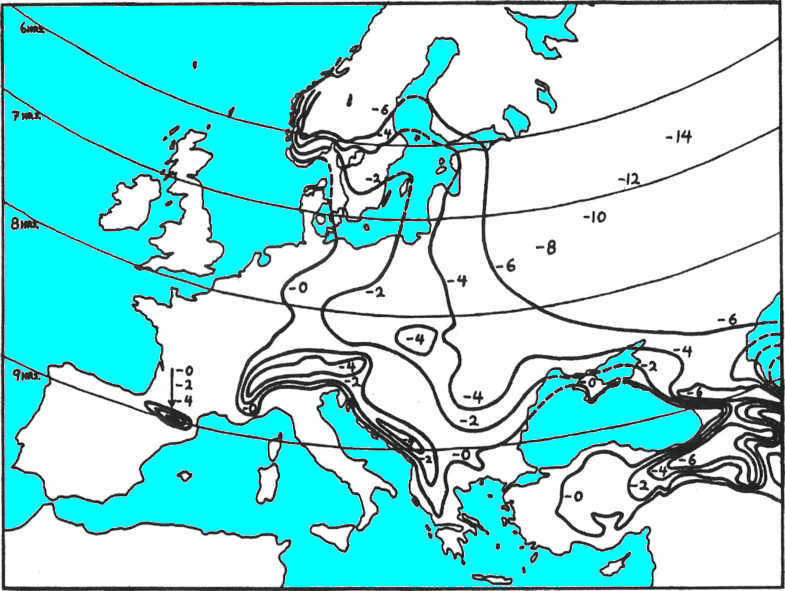 |
24
The basic rates of advance for peoples with other adaptations are calculated using the same kinds
of penalties. The same geographic lines of temperature and sunlight are used, the same four
increments are assessed and held constant thereafter, and the added increment is always one-third of
the basic advance rate under ideal circumstances. Thus with (sheep)
herders, whose basic advance rate is 75 years per 200-km unit, 25 more years are added for each step
in each of these two factors, so their slowest advance rate is 275 years per 200 km.
In the following descriptive sections different advance rates for other circumstances are
described as they are introduced. They mostly follow this same basic pattern.
No special penalties or delays were introduced for adjustments to new zones of flora and fauna as
were used in my North American study. Here it was considered that Neolithic farmers were bringing
with them so much of these important items (domesticated) that any changes in the local situation
would have had only a trivial effect. Also, no time penalties were assessed for building boats at
significant water gaps. As will be seen, there were always other people with shipping available at
each such place.
Three more limiting factors of geography may be introduced at this point, as illustrated in
Fig. 5. In many places the soil was (and is) too deep and/or heavy to be plowed with the early
"scratch plow" that simply cut a furrow. Such soils are mostly randomly distributed, but some major
and extensive areas are shown that effectively blocked the entry of large numbers of farmers until
new techniques were developed.
A northern farming limit, for most practical purposes, exists along the line of the 120-day
growing season. This line would move somewhat during different eras, but it largely marks the end of
the Neolithic advance. Only much later did new species and strains of crops enable farmers to pass
this line to some degree.
Mountain barriers would sometimes impede Neolithic progress and significantly retard
communications across them. Ethnic boundaries sometimes developed along these, and continued at the
meeting lines beyond.
25
|
Fig. 5. Geographic factors. Stippled areas in Hungary and Russia are deep soils that could
not be plowed by Neolithic farmers. The Moors of Scotland, the Po Valley, and central Anatolia
present equivalent situations. To the north is the limit of the 120-day growing season. Some
mountains are shown, but only those that affected ethnic movements. |
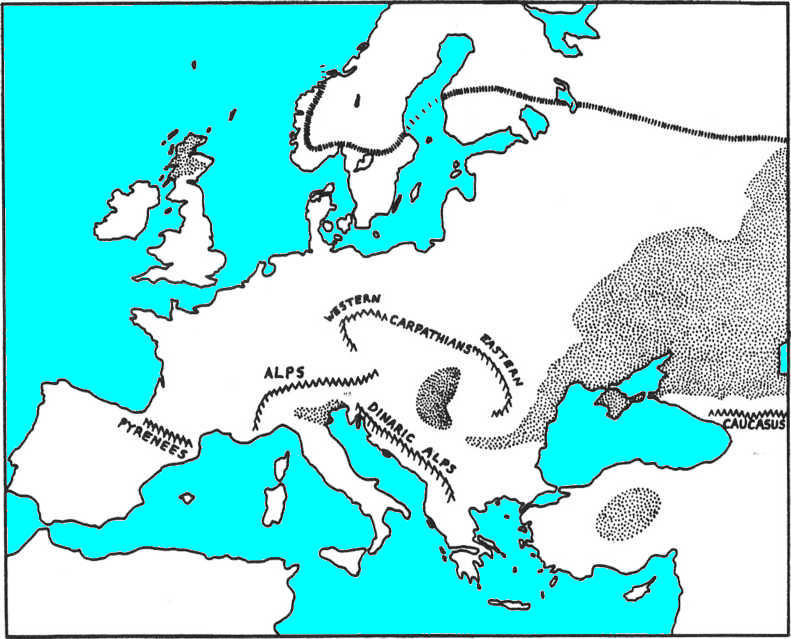 |
26
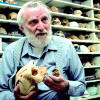
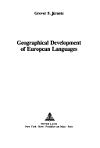
![]()
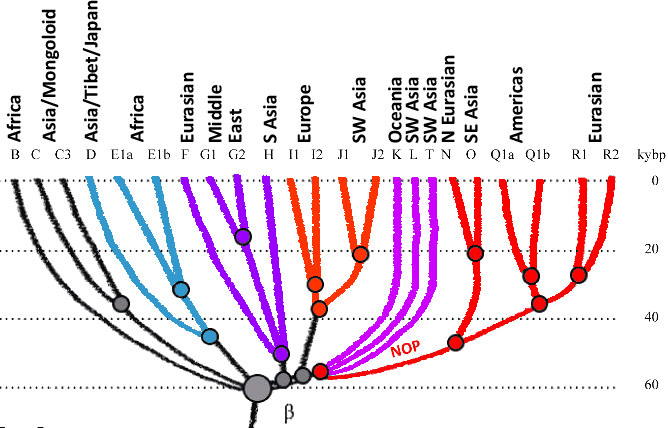

 This work
presents a new approach for reconstructing the geography of prehistoric language differentiations
and distributions. It is made explicit in the form of a complete reconstruction of the origin and
distribution of all present European languages, and many extinct ones as well. Both the method
itself and the results of its application to Europe are offered for critical evaluation by scholars
in the appropriate fields.
This work
presents a new approach for reconstructing the geography of prehistoric language differentiations
and distributions. It is made explicit in the form of a complete reconstruction of the origin and
distribution of all present European languages, and many extinct ones as well. Both the method
itself and the results of its application to Europe are offered for critical evaluation by scholars
in the appropriate fields.
 Notes on
sources
Notes on
sources Language
Differentiation
Language
Differentiation Rules of
Movement
Rules of
Movement




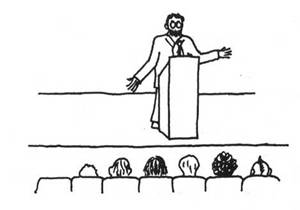
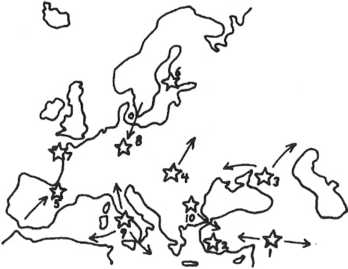 Major Innovations
Major Innovations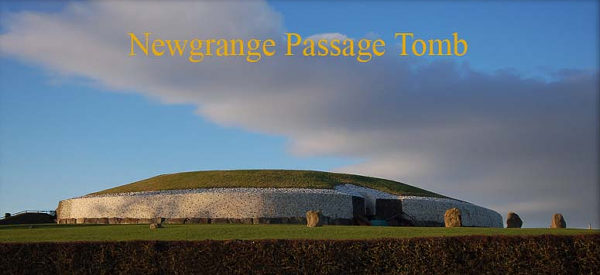
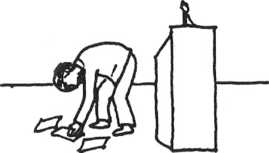 Problems Remaining
Problems Remaining